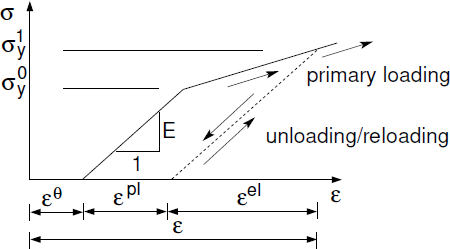Elastic-plastic models with hardening/softening
Application of elastic-plastic material models with hardening/softening allows for a gradual evolution of yield surface in dependence on the evolution of plastic strains.
This is schematically illustrated in the stress-stress diagram, where σy0 represents the initial yield strength separating an elastic and plastic response. When arriving at the yield strength the stress at a given material point may further increase, the material hardens (or potentially decrease, the material softens). After subsequent unloading and reloading sequence the material behaves linearly elastic until reaching the new yield strength σy1. From that point on the material continues to deform plastically.
On the contrary, the elastic-perfectly plastic material models assume no evolution of the yield strength.
Beyond the elastic limit the increment of overall strain Δε corresponds to the increment of plastic strain Δεpl. Unlike linear models the initial strain is a sum of the strain caused by a temperature change εθ = αΔθ, where α is the coefficient of thermal expansion, and plastic strain εpl, i.e., ε0 = εθ + εpl. The stress is calculated from the elastic part of the overall strain εel = ε - ε0, i.e., σ = Eεel. Determination of the plastic strain is driven by the selected type of the material model.

The class of elastic-plastic material models with hardening/softening include the Hardening soil, Soft soil, Modified Mohr-Coulomb models.